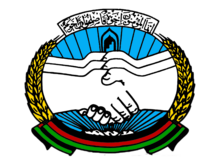Khalq
Its historical de facto leaders were Nur Muhammad Taraki (1967–1979), Hafizullah Amin (1979)[5] It was also the name of the leftist newspaper produced by the same movement.
The Khalq wing was formed in 1967 after the split of the party due to bitter resentment with the rival Parcham faction which had a differing revolutionary strategy.
Its leaders preferred a mass organization approach and advocated class struggle to overthrow the system to bring about political, economic and social changes.
The Khalqists introduced radical reforms and carried out brutal crackdowns on dissent turning Afghanistan into a police state run by the AGSA (and later KAM).
The Khalqist crackdowns encouraged the rebellion of the religious and ethnic minority segments present in the Afghan society, which led more people joining exiled Islamist parties in Pakistan.
[7] Especially on the ideological level, Karmal and Taraki differed in their perceptions of Afghanistan's revolutionary potential: The newspaper was highly successful, especially among students.
Taraki did advocate a united front briefly after former Prime Minister Mohammad Daoud Khan's takeover in an attempt to gain places in the government for his followers, but this effort was unsuccessful.
The Khalqis claimed to be more leftist and more independent of the Soviet Union than Parcham, but their base of support was not strong among the masses, and much stronger in the military.
Because of this, Khalq abandoned his party's traditional emphasis on working-class recruitment and sought to build his own power base within the officer corps.
He was the last person to be arrested, his imprisonment was postponed for five hours, during which time Amin, without having the authority and while the Politburo members were in prison, instructed the Khalqi army officers to overthrow the government.
Colonel Abdul Qadir, the leader of the Air Force squadrons, also launched a major attack on the Royal Palace, in the course of which President Mohammad Daoud Khan and most of his family, including women and children, were assassinated.
[8] The Saur Revolution, as the new government labeled its coup d'état (after the month in the Persian calendar in which it occurred), was almost entirely the achievement of the Khalq faction of the PDPA.
Initially, the revolutionary government of Khalq had a period of acceptance from the Afghan populace partly due to its land reform program.
They also embarked on a campaign of land reform that resulted in the arrest and summary execution of tens of thousands who opposed the Khalq policy of encouraging the education of girls.
PDPA general secretary Nur Mohammad Taraki refused to tolerate any Parchamis in the military and insisted that all officers affiliate with Khalq.
In late October, Amin made a military sweep against the insurgents, victoriously driving 40,000 people – mostly non-combatants – across the border into Pakistan.
The USSR attempted to temper the Khalqis' radicalism, urging attendance at mosques, inclusion of Parchamis and non-communists in the government, and a halt to the unpopular land reform movement.
The last Khalq leader, Hafizullah Amin, was assassinated after Soviet intelligence forces took control of the government and installed Babrak Karmal, a Parchami, in his place.
This split persisted, forcing PDPA leader Najibullah to straddle his politics between whatever Parchami support he could maintain and alliances he could win from the Khalqists.
In March 1990, once again the Mujahideen leader Gulbuddin Hekmatyar cooperated in a coup attempt, this time led by the Khalqist Defense minister Shahnawaz Tanai.
Tanai was apparently also supported by those important Khalqist who remained in the Politburo, Assadullah Sarwary and Mohammad Gulabzoi, respectively their country's envoys to Aden and Moscow.

